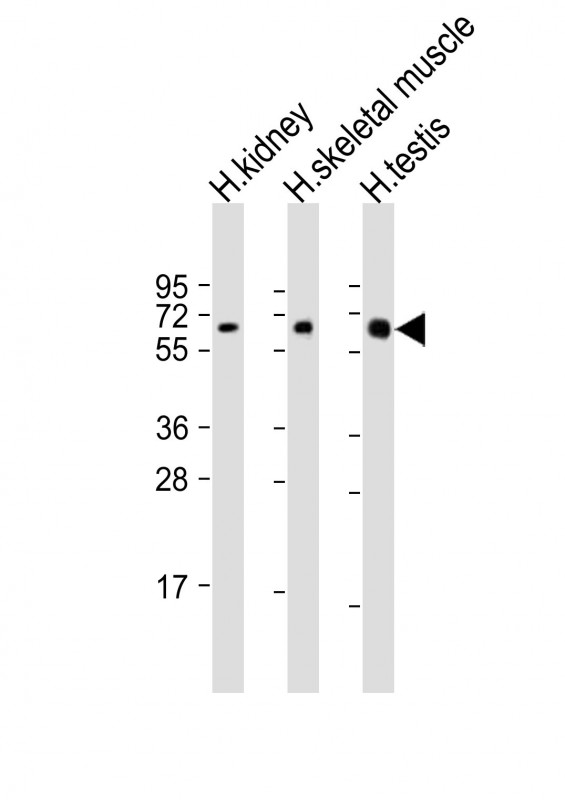DMRT2 Antibody (Center)
Purified Rabbit Polyclonal Antibody (Pab)
- SPECIFICATION
- CITATIONS
- PROTOCOLS
- BACKGROUND

Application
| WB, E |
|---|---|
| Primary Accession | Q9Y5R5 |
| Reactivity | Human |
| Host | Rabbit |
| Clonality | polyclonal |
| Isotype | Rabbit IgG |
| Calculated MW | 61814 Da |
| Gene ID | 10655 |
|---|---|
| Other Names | Doublesex- and mab-3-related transcription factor 2, Doublesex-like 2 protein, DSXL-2, DMRT2, DSXL2 |
| Target/Specificity | This DMRT2 antibody is generated from a rabbit immunized with a KLH conjugated synthetic peptide between 357-392 amino acids from the Central region of human DMRT2. |
| Dilution | WB~~1:2000 E~~Use at an assay dependent concentration. |
| Format | Purified polyclonal antibody supplied in PBS with 0.09% (W/V) sodium azide. This antibody is purified through a protein A column, followed by peptide affinity purification. |
| Storage | Maintain refrigerated at 2-8°C for up to 2 weeks. For long term storage store at -20°C in small aliquots to prevent freeze-thaw cycles. |
| Precautions | DMRT2 Antibody (Center) is for research use only and not for use in diagnostic or therapeutic procedures. |
| Name | DMRT2 |
|---|---|
| Synonyms | DSXL2 |
| Function | Transcriptional activator that directly regulates early activation of the myogenic determination gene MYF5 by binding in a sequence-specific manner to the early epaxial enhancer element of it. Involved in somitogenesis during embryogenesis and somite development and differentiation into sclerotome and dermomyotome. Required for the initiation and/or maintenance of proper organization of the sclerotome, dermomyotome and myotome (By similarity). |
| Cellular Location | Nucleus {ECO:0000255|PROSITE-ProRule:PRU00070}. |
| Tissue Location | Expressed in testis, kidney and skeletal muscle. |

Thousands of laboratories across the world have published research that depended on the performance of antibodies from Abcepta to advance their research. Check out links to articles that cite our products in major peer-reviewed journals, organized by research category.
info@abcepta.com, and receive a free "I Love Antibodies" mug.
Provided below are standard protocols that you may find useful for product applications.
Background
Transcriptional activator that directly regulates early activation of the myogenic determination gene MYF5 by binding in a sequence-specific manner to the early epaxial enhancer element of it. Involved in somitogenesis during embryogenesis and somite development and differentiation into sclerotome and dermomyotome. Required for the initiation and/or maintenance of proper organization of the sclerotome, dermomyotome and myotome (By similarity).
References
Raymond C.S.,et al.Hum. Mol. Genet. 8:989-996(1999).
Ottolenghi C.,et al.Genomics 64:179-186(2000).
Calvari V.,et al.Genomics 65:203-212(2000).
Humphray S.J.,et al.Nature 429:369-374(2004).
Mural R.J.,et al.Submitted (SEP-2005) to the EMBL/GenBank/DDBJ databases.
If you have used an Abcepta product and would like to share how it has performed, please click on the "Submit Review" button and provide the requested information. Our staff will examine and post your review and contact you if needed.
If you have any additional inquiries please email technical services at tech@abcepta.com.













 Foundational characteristics of cancer include proliferation, angiogenesis, migration, evasion of apoptosis, and cellular immortality. Find key markers for these cellular processes and antibodies to detect them.
Foundational characteristics of cancer include proliferation, angiogenesis, migration, evasion of apoptosis, and cellular immortality. Find key markers for these cellular processes and antibodies to detect them. The SUMOplot™ Analysis Program predicts and scores sumoylation sites in your protein. SUMOylation is a post-translational modification involved in various cellular processes, such as nuclear-cytosolic transport, transcriptional regulation, apoptosis, protein stability, response to stress, and progression through the cell cycle.
The SUMOplot™ Analysis Program predicts and scores sumoylation sites in your protein. SUMOylation is a post-translational modification involved in various cellular processes, such as nuclear-cytosolic transport, transcriptional regulation, apoptosis, protein stability, response to stress, and progression through the cell cycle. The Autophagy Receptor Motif Plotter predicts and scores autophagy receptor binding sites in your protein. Identifying proteins connected to this pathway is critical to understanding the role of autophagy in physiological as well as pathological processes such as development, differentiation, neurodegenerative diseases, stress, infection, and cancer.
The Autophagy Receptor Motif Plotter predicts and scores autophagy receptor binding sites in your protein. Identifying proteins connected to this pathway is critical to understanding the role of autophagy in physiological as well as pathological processes such as development, differentiation, neurodegenerative diseases, stress, infection, and cancer.


